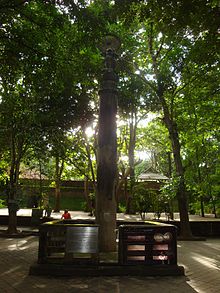Wat Umong
This article needs additional citations for verification. (August 2012) |

Wat Umong (complete name: Wat Umong Suan Puthatham) is a 700-year-old Buddhist temple in Chiang Mai, Thailand.
It should not be confused with the temple with a similar name within the old city moat of Chiang Mai, whose complete name is "Wat Umong Maha Thera Chan".[1]
Location[edit]
Wat Umong is located against the mountains of Doi Suthep and is about 1 km south of the main campus of Chiang Mai University. The wat occupies a tranquil setting and a small open zoo is stationed behind it.[2]
History[edit]

The temple was built in 1297 by King Mangrai of the Lan Na dynasty.[2]
Of particular interest is a modern replica of the original standing condition of the pillar of Ashoka at Sarnath in India. The Lion Capital of Ashoka survives in the Sarnath Museum, in an incomplete state, and at Indian independence was adopted as the National Emblem of India. It consists in four lions standing on an abacus, crowned by a large wheel called a Dharmachakra.[5]
Structure and layout[edit]


The entire Wat Umong complex consists of 37.5 rai (15 acres) of wooded grounds. You can feed the fish, turtles, and ducks in a large pond. "Talking trees" have words of wisdom in Thai and English. The wat is famous for its ancient tunnels and large chedi. There are tunnels with Buddhist images below the chedi which can be easily explored. These tunnels were supposedly built by the King and painted with bush scenes so they could keep a famous but mentally deranged monk within the grounds of the monastery as he had a habit of just wandering off into the bush for days on end. Signs (proverbs) written in English and Thai hang from the trees on footpaths leading to the small lake where fish, pigeons, and turtles can be fed.
Other attractions include a Buddha field of broken sculpture, a fasting Bodhisattva, a Spiritual Theatre of paintings similar to those at Suan Mokkh, reproductions of ancient Buddhist sculpture of India, and a library-museum. This last building offers many books on Buddhism and other philosophies as well as a collection of historic objects and Buddhist art.[6]
Current status[edit]
Wat Umong is unique in that the resident monks live in a very natural setting, and occasionally feed the deer that live in the area. It also is possible to practice meditation at Wat Umong and to learn from the monks.[7]
References[edit]
- ^ Name of the other Wat Umong as visible on Streetview
- ^ a b Hoskin, John (1998). A Guide to Thailand. Passport Books. p. 147. ISBN 9780844297170. Retrieved 26 August 2012.
- ^ Lahiri, Nayanjot (25 June 2016). "Re-searching Ashoka in Thailand". The Hindu.
On reaching the environs of Wat Umong, the excitement became more muted. The pillar was certainly a reproduction of the Sarnath Ashokan column, but (alas!) a modern reproduction of it. This could neither be dated to the 13th century, nor did it have any connection with a king of the Lanna line. The cement and concrete replica was set up some decades ago on the initiative of the Buddhist monastic community and its patrons at Wat Umong. They also got copies made of sundry sculpted panels from Buddhist sites in India.
- ^ Sen, Colleen Taylor (17 October 2022). Ashoka and the Maurya Dynasty: The History and Legacy of Ancient India’s Greatest Empire. Reaktion Books. p. 272. ISBN 978-1-78914-595-3.
- ^ Thanjan, David K. (2011). Pebbles. ISBN 9781589098176. Retrieved 27 August 2012.
- ^ Dhammathai Meditation Places in Thailand
- ^ Information about meditation and learning on the temple's website
